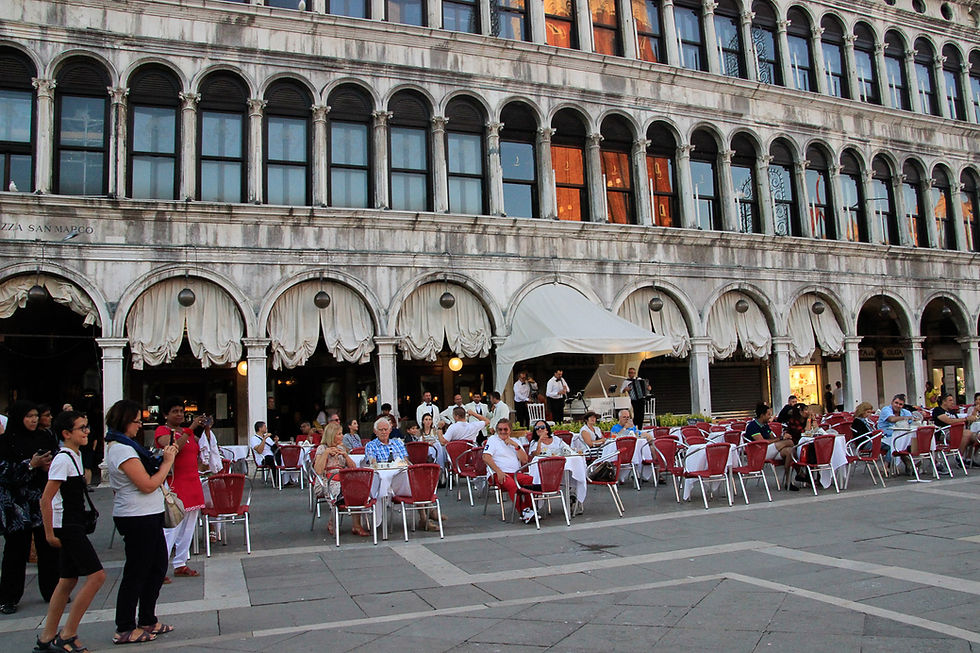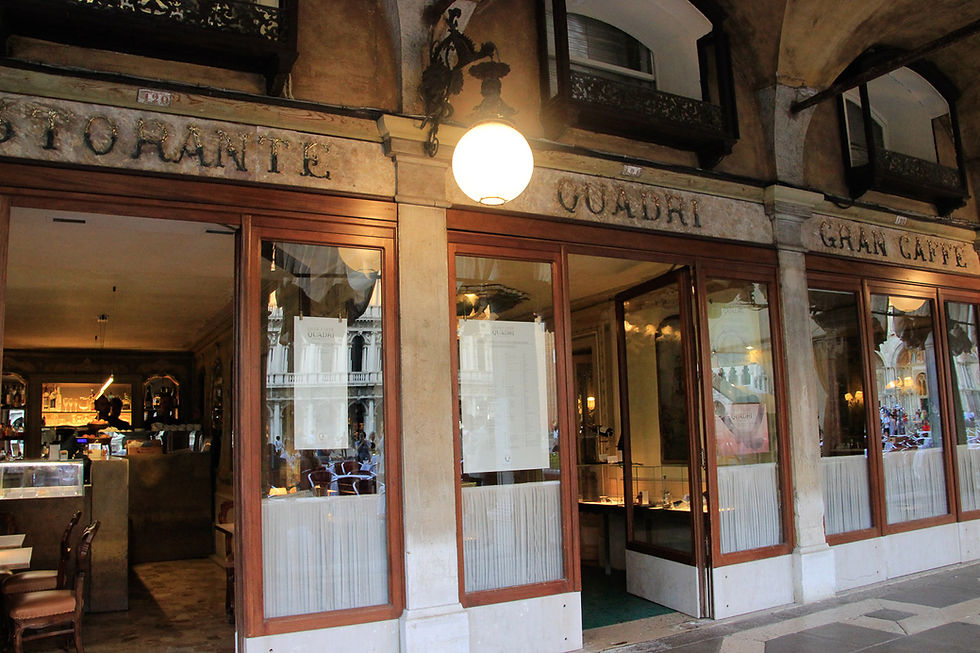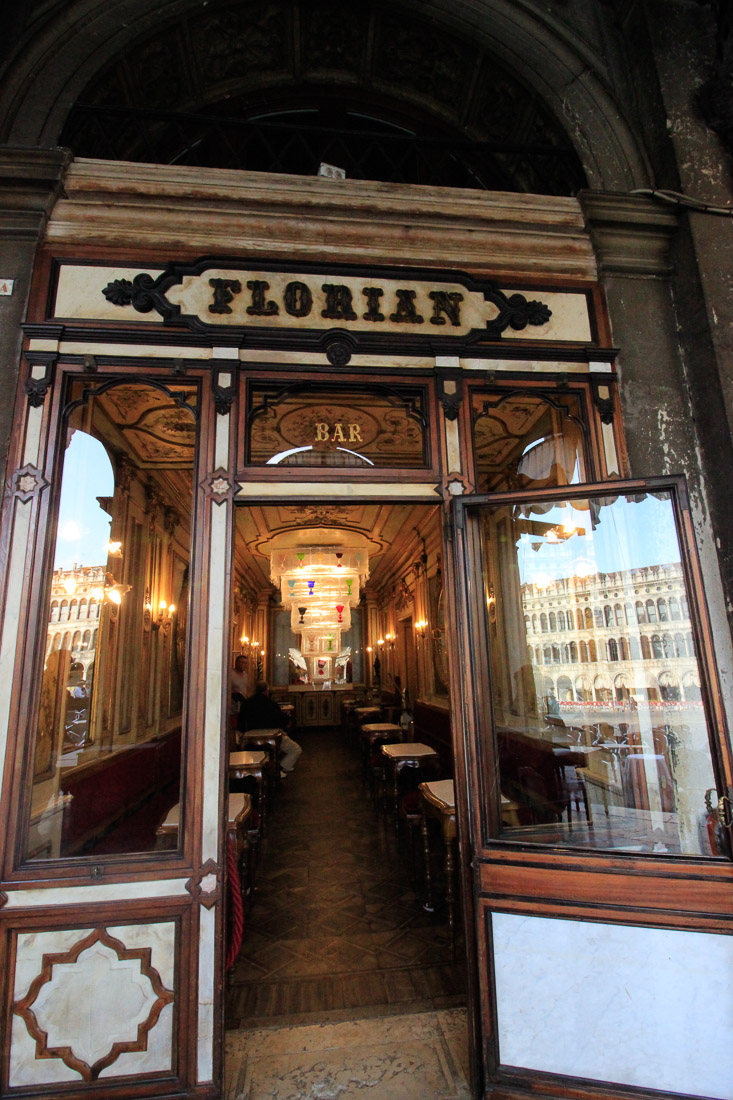Venetians' passion for coffee
- Venecisima Venecisima
- 20 sept 2020
- 4 Min. de lectura
Actualizado: 30 nov 2022
The history of coffee in Europe began in the city of Venice at the end of the 17th century. Discover the oldest and most elegant historical cafes in Venice, from whose windows a part of the history of this city took place.
Today we accompany you on an unconventional itinerary: THE HISTORICAL CAFÉS OF VENICE

Testimony of the passion of the Venetians for coffee is the legend that says that Casanova, after fleeing the jails of the Doge's Palace, the terrible Piombi, stopped at the famous Café Florian and asked for a cup of coffee before leaving Venice
THE FIRST LARGE IMPORTERS OF COFFEE
The drink did not have an easy start, as it came from "pagan peoples", and its black color suggested that it was a creation of Satan. Fortunately, Pope Clement VII (1582-1605) liked it when tasting it and "baptized" it as a Christian drink.
Also coffee had problems in Venice. Not only because they regarded the Turks as a "hairy enemy", but also because of reports, coming from Constantinople, and that they associated drinking with impotence and homosexuality.
Still, the Venetians decided to import coffee and were the first major coffee importers in Europe. The first shipment of coffee landed in Venice in 1624 from Constantinople.
The drink, extracted from seeds called Bon, took the name of coffee in Venice, where it spread rapidly at the end of the 17th century.
COFFEE WAS SOLD IN PHARMACIES
At first, however, it was considered a kind of medicine and was sold in pharmacies, at a fairly high price. Later it was sold in coffee shops and, being imported in large quantities, it became a fashionable drink, available to all social classes.

Thus, a writing by the theologian Domenico Magri, from 1671, considered the drink as a remedy for many illness:
"Continual experience clearly shows us that the Kafè admirably eliminates catarrhal processes, as well as other diseases of the liver and without harming the stomach, Hence, the Turks never suffer from colds, nor do their teeth hurt, nor are they tormented by gout attacks, or similar diseases, in fact they believe that coffee smoke helps against eye diseases, and that is why they stand up before they drink it "
THE CAFETERIAS
The coffee shops were introduced in the city in 1683 when some Turkish merchants opened a shop to taste coffee in the Piazza San Marco, under the arcades of the Procuratie Nuove. It was an unstoppable phenomenon, because in 1759 the city had 206 coffee shops!
The cafeteria was a meeting place for lovers, where women were courted by offering them a tray of chocolate or coffee. Many cafe owners created small rooms or dressing rooms , where couples locked up to have fun.
In 1766 the Inquisitors ordered that women of any condition not be allowed to enter any of the shops in the waters, which is how the cafeterias were called. But in reality the fury of the inquisitors against the coffee shops was more political than moralistic, since liberal ideas were spread in these places.
The "Cafes" (as they were called) were commercial and meeting places for people from all walks of life: intellectuals, academics, politicians, students, artists and ordinary people. The atmosphere of the cafe resembled the living room at home, and the coffee was mainly taken at the table.

This is how Antonio Lamberti describes cafeterias in 1802: “The rooms were low, modest, unadorned, without windows, poorly lit by a flickering light, but inside they brought the varied and joyful crowd with graceful robes like a breath of elegance. they were divided into noisy groups, among which there was gossip"
In short, the cafeterias became a mode of meeting and gathering outside Venetian houses and palaces where new ideas were exchanged

A WALK THROUGH THE HISTORICAL CAFETERIAS
1. CAFÉ FLORIAN
The Most famous of all the cafes remains the Florian. He was born in 1720 with the name Alla Venezia Trionfante. Like the first cafes, it was more of a room with simple banquettes than a luxurious lounge. It also had a small terrace that allowed you to spy on the life of St. Mark's Square, which then was like a lively souk with street vendors, fortune-tellers, Albanians, monks, pilgrims, beggars, German musicians ...

The Café was renamed "Caffé Florian" in honor of its owner, Floriano Francesconi.
While the best wines and coffees from the East, Malaysia, Cyprus and Greece were being served, the story unfolded outside. Its windows witnessed the splendor and fall of the Serenissima Republic of Venice and the secret conspiracies against French and then Austrian rule.
Important people such as: Lord Byron, Vivaldi, Goethe, Rousseau, Stravinski... and also Casanova, have passed through this cafe.
2. GRAN CAFE QUADRI
Its activity began in 1775 when the Venetian merchant Giorgio Quadri, returned home after a long stay in Corfu , then part of the Republic of Venice, together with his Greek wife, Naxina, and decided to open a room where to prepare and sell coffee.
Giorgio Quadri opened his restaurant under the Procuratie Vecchie, took over an old wine and café shop already known in the city and his café soon became one of the favorite haunts of the Venetian aristocracy.



During his stay in Venice, among the historical characters who sat in its rooms were Stendhal, George Byron, Richard Wagner, Marcel Proust and, in more recent times, Michail Gorbachev, François Mitterrand and Woody Allen.
3. HARRY'S BAR
It is not properly a historic café but inside it was spent the intellectual afternoons of artists and writers such as Arturo Toscanini, Guglielmo Marconi, Charlie Chaplin, Orson Welles or Peggy Guggenheim.
And here, too, the Bellini drink and the famous Carpaccio emerged. Discover its history here.

4 . CAFÉ LA CALCINA
The name comes from the caleros - lime sellers - who had their warehouse here in the 17th century.T he former warehouse turned into housing, inn, guest house and finallyhotel.
It is currently recognized as one of the historic cafes in Europe.
It has been appreciated for at least a couple of centuries by travelers from all over the world and by writers such as the French André Suarés; Philippe Sollers and John Ruskin (stayed here in the spring of 1877)

5. LION'S BAR EN EL LIDO
It is part of the Palazzo del Cinema area of Venice and is located on the island of Lido, so if you are in Venice you will have to take the vaporetto to get here.
The Lion's Bar was designed by Giovanni Sicher in 1925 and is a classic example of Art Decò from the 1920s. It is a place frequented by journalists and photographers during the Film Festival.













Comments